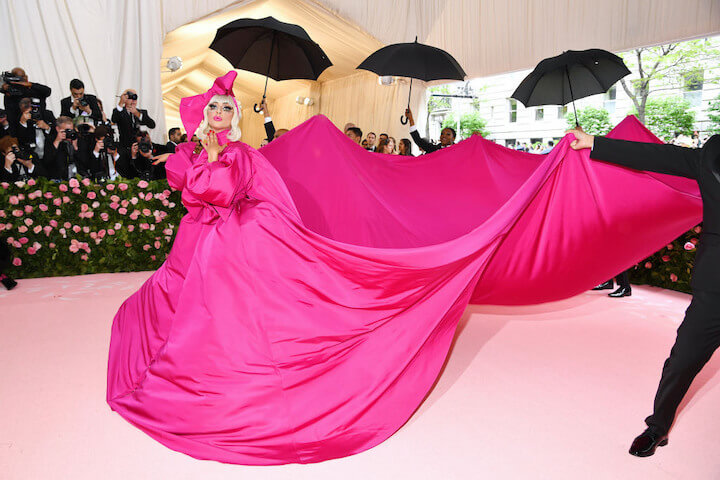(寄稿) 悪趣味なものを楽しむ―スーザン・ソンタグの《キャンプ》論 松本理沙
2021.3.3 (Wed)
フェスティバルプログラムをより楽しむためのコラムです。このコラムとあわせて、ぜひ楽しんで欲しいおすすめプログラムも紹介しています。(KYOTO EXPERIMENT magazineより転載)
KYOTOEXPERIMENTが実験的な表現に焦点をあて、舞台芸術の新しい可能性に挑戦する表現を紹介していく中で、スーザン・ソンタグの《キャンプ》論で語られている概念は、それらを読み解くヒントになるかもしれません。ソンタグのエッセイを中心に、露悪的なもの、悪趣味なものに対する一つの姿勢を紐解き、改めて《キャンプ》論について振り返ります。
ドラァグクイーンやMETGALA2019におけるセレブ達の、けばけばしく、過度に誇張された衣装。「キャンプ」という語を耳にしたとき、まず思い出されるのはこうしたものだろう。確かにドラァグクイーンはキャンプの象徴であるものの、かといって単に派手な色彩を用い、劇的なまでに性を強調すればキャンプになるというわけではない。では一体、キャンプとはなんであるのか。この語を一躍日常語にまで高めたアメリカの批評家スーザン・ソンタグによる記念碑的テクスト「《キャンプ》についてのノート」(1964)によると、キャンプとは「一種の愛情」であり、「やさしい感情なのだ」という。愛情? やさしい感情? 我々が知るキャンプのイメージとは程遠いこれらの語は、どのような意味で用いられているのだろうか。ソンタグのテクストを辿ることによって、「世界を美学的現象として見るひとつのやり方」である、キャンプという語の持つ奥行きを理解するとしよう。
オーブリー・ビアズリーや1933年の映画《キング・コング》、1920年代のファッション(羽毛の襟巻やひだ飾り、ビーズのついたドレスなど)まで、ソンタグがキャンプという語彙でくくる範囲は広い。中でも彼女がキャンプの典型として挙げるのは、アール・ヌーヴォーである。アール・ヌーヴォーとは、19世紀末に出現した、女性的な曲線や有機的な形態を用いる装飾的な芸術様式だ。伝統的な職人仕事の復権や重苦しい歴史主義的建築からの解放など、真面目な内容を持つ一方で、アール・ヌーヴォーの作品群を前にしたとき我々を圧倒するのは、過度な曲線による装飾である。この過剰なまでに華美な装飾を楽しむ姿勢が、ソンタグによるとキャンプなのだという。
しかし、単に誇張されたけばけばしさを称揚するのであれば、はじめに挙げたドラァグクイーンやMETGALA2019を巡るイメージと大差ない。ソンタグがいうには、アール・ヌーヴォーのように至極真面目に作られた政治的、道徳的なものを、不真面目なものとして受け取るところにキャンプの神髄があるのだという。常軌を逸した精神による真面目さを、過度に装飾されたそのふざけたスタイルとして享受するという態度こそが、彼女のいうキャンプなのだ。
キャンプとはいわば「失敗した真面目さ」なのであるが、これをくだらないものとして切り捨てるようでは、キャンプな姿勢からは程遠い。むしろ、美や誠実さのような道徳的基準から解放し、失敗した真面目さの享楽を味わうようになってはじめて、キャンプな見方は可能になるのである。すなわちキャンプとは、悪趣味なものを禁欲的に締め出すのではなく、それを快楽として受け取り、愛で、楽しむ姿勢といえるだろう。そのためには、常軌を逸したものを受け入れる器の広さが不可欠だ。だからこそ、「キャンプとは一種の愛情」であり、「やさしさ」なのである。
ソンタグが綴るキャンプとは、常軌を逸した精神によってつくられた真面目さを、不真面目な、ふざけた精神で受け入れ、それを楽しむという寛容の精神である。大げさで誇張された表現を楽しみ、享受すること―この喜びを我々に教えるソンタグのテクストは、あらゆるものを無害化しようとする今日にこそ読み直されるべきものかもしれない。下品さや不真面目さを抑圧するのではなく、それすらも楽しむ態度を提示した彼女のテクストは、今もなおその瑞々しさを失っていないのである。
松本理沙
1994年生まれ。京都大学大学院人間・環境学研究科博士後期課程在籍。専門は芸術学。論文に「ロバート・モリス《グランドラピッズ・プロジェクト》における知覚体験――その使用価値に着目して」(『美学』第257号)など。
#遊び #皮肉 #ハイ&ロウ #誇張
